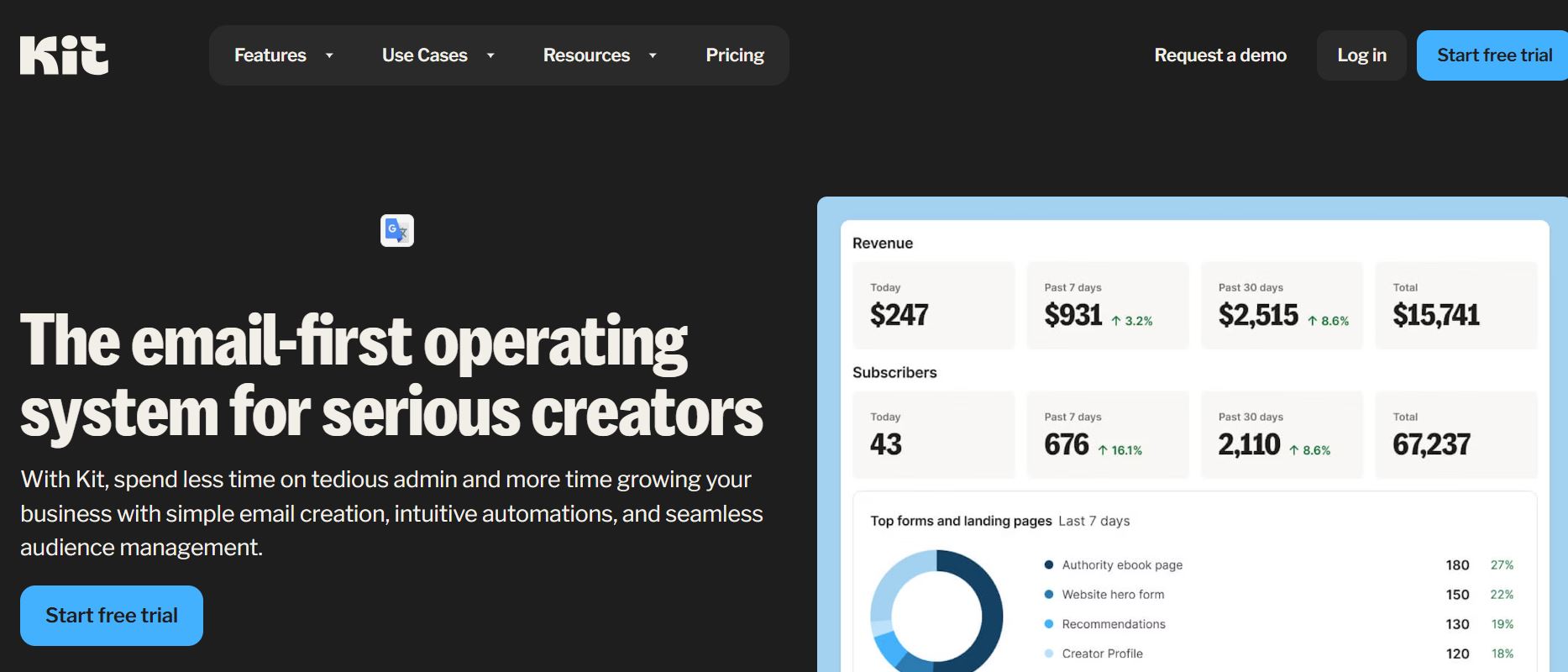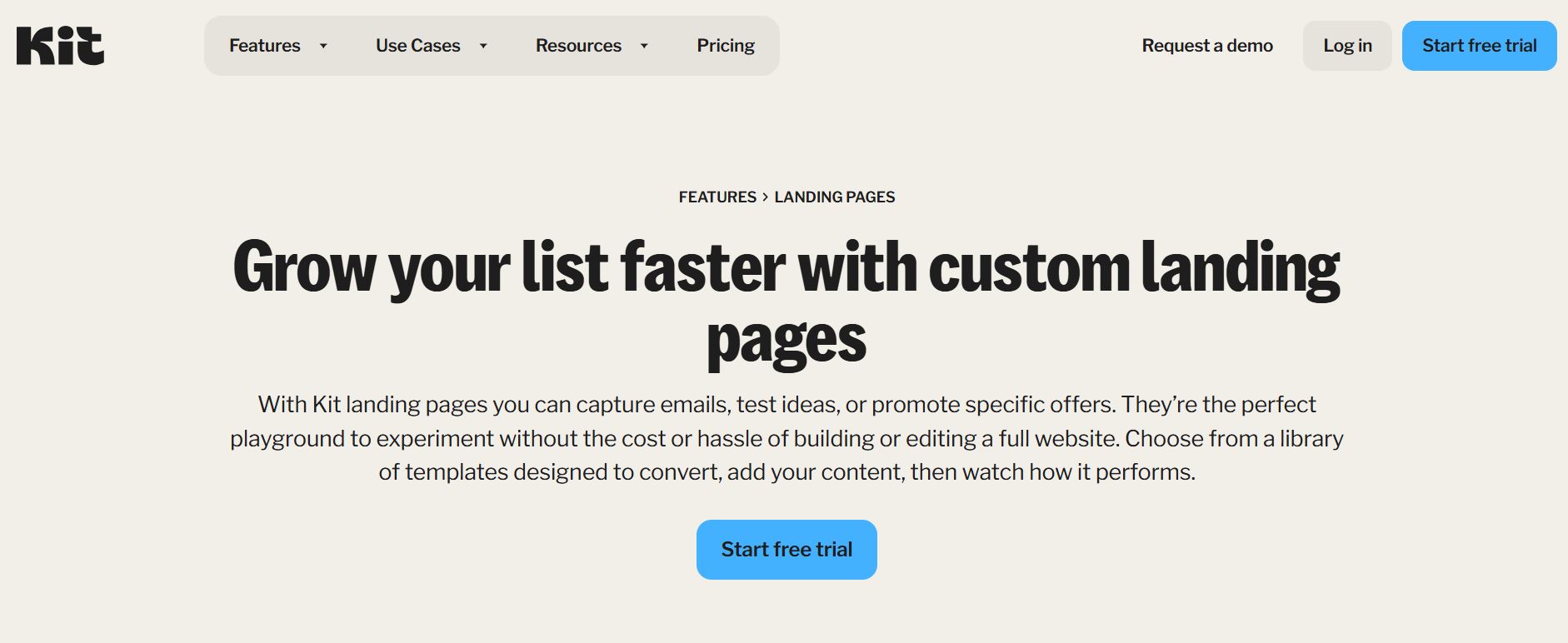If you’re a creator, you know that building an audience isn’t just about posting great content; it’s about connection. And email is one of the best ways to do that.
That’s where ConvertKit comes in. It’s an email marketing platform built specifically for creators, bloggers, and small businesses—helping you grow your audience and turn subscribers into loyal fans.
With ConvertKit, you can automate emails, segment your audience, and easily create landing pages.
What is ConvertKit?
ConvertKit is more than just another email marketing tool—it’s a platform built for creators, by creators. Whether you’re a blogger, course creator, podcaster, or small business owner, it gives you the tools to send targeted emails, automate sequences, and even sell digital products—all without the overwhelm.
So, what makes it different from other email marketing platforms?
- Simplicity: The clean, user-friendly interface makes it easy to set up email campaigns without frustration.
- Powerful Automation: Create smart email funnels without manual work that send the right message at the right time.
- Creator-Focused Features: Unlike Mailchimp or Constant Contact, ConvertKit is built for people who make content. It offers tag-based subscriber management, email personalization, and even built-in tools for selling digital products.
The bottom line? If you’re a creator looking for an email marketing tool that actually understands your needs, ConvertKit is one of the best options.
Features of ConvertKit
ConvertKit isn’t just about sending emails; it’s about sending the right emails to the right people at the right time.
Whether you’re nurturing leads, selling a product, or growing your newsletter, these features help make it happen.

1. Email Automation & Sequences
ConvertKit’s visual automation builder makes setting up email workflows effortless.
You can create custom sequences based on subscriber actions, such as signing up for a freebie, clicking a link, or making a purchase.
For example, let’s say someone downloads your lead magnet. Instead of manually following up, ConvertKit automatically sends emails to nurture them toward your paid offer.
It’s all drag-and-drop, so you don’t need to be a tech expert to build powerful automations.
2. Landing Pages & Forms
You don’t need a separate website or design skills to capture leads. ConvertKit offers high-converting landing pages and opt-in forms that you can customize easily.
There are beautiful, mobile-friendly templates to choose from, plus built-in tools to track conversions. Whether you’re growing your email list with a freebie or promoting an upcoming course, ConvertKit makes it simple.
3. Audience Segmentation
Not all subscribers are the same, so why send them the same emails?
With ConvertKit’s tag-based subscriber management, you can group people based on behavior, interests, or how they signed up. This means:
- Sending personalized emails to different segments
- Tagging buyers separately from free subscribers
- Creating smart automation rules for more engagement
This helps boost email open rates and conversions since people get content tailored to their interests.
4. Broadcast Emails & Drip Campaigns
Do you want to send a one-time newsletter or a drip campaign that delivers content over time? ConvertKit lets you do both seamlessly.
- Broadcast emails are great for announcements, promotions, or weekly newsletters.
- Drip campaigns let you send a scheduled series of emails, which is perfect for onboarding new subscribers or running an automated challenge.
And with ConvertKit’s clean email editor, writing and scheduling emails is distraction-free.
5. E-commerce & Creator Monetization
One of ConvertKit’s most unique features is its built-in tools for selling digital products and subscriptions without requiring a separate platform.
You can sell:
- E-books, courses, and templates
- Memberships and paid newsletters
- One-time or recurring subscriptions
This is a game-changer for creators who want to monetize their audience without relying on third-party tools.
6. Integrations
ConvertKit works smoothly with the tools you’re already using, including:
- WordPress, Shopify, and Teachable for seamless website and course integration
- Zapier to connect with thousands of apps.
- Stripe for simple payment processing
There are no complicated setups—plug it in and start automating.
Benefits of ConvertKit
So why choose ConvertKit over other email marketing platforms? Simple. It’s built with creators in mind—helping you grow, engage, and monetize your audience without the usual headaches.
1. Simple & User-Friendly
One of ConvertKit’s biggest strengths is its clean and intuitive interface. Unlike other email marketing tools, which feel overwhelming, ConvertKit makes everything simple—from setting up automation to designing emails.
Even if you’re new to email marketing, you can:
- Create an email sequence in minutes using the visual automation builder
- Easily tag and segment subscribers without getting lost in complicated settings.
- Write and format emails with a distraction-free editor.
No unnecessary features. No steep learning curve. Just email marketing that works.
2. Powerful Email Automation
Automation can feel intimidating, but ConvertKit makes it easy.
With its drag-and-drop automation builder, you can set up advanced email workflows without coding or complex rules. Whether you want to:
- Send a welcome sequence after someone signs up.
- Automate a sales funnel based on subscriber actions.
- Deliver an online course via email.
ConvertKit’s automation tools handle it seamlessly, so you can focus on creating instead of managing emails.
3. Built for Creators
Most email marketing platforms are built for businesses, while ConvertKit is built for creators.
That means:
- Bloggers can send personalized newsletters and grow their email list effortlessly.
- Podcasters can engage listeners with automated updates and promotions.
- Course creators can sell digital products and deliver content directly through email.
Everything in ConvertKit is designed to help you grow and monetize your audience without bogging you down with unnecessary features.
4. High Deliverability Rates
It doesn’t matter how great your emails are if they end up in spam folders.
ConvertKit has one of the highest email deliverability rates in the industry—meaning your emails actually reach your subscribers’ inboxes. This is thanks to:
- Clean email sending practices that improve deliverability
- Advanced email authentication to reduce spam issues
- Subscriber tagging and segmentation to keep lists engaged
More emails reaching inboxes = higher open rates, more engagement, and better results.
5. Seamless Integrations
Already using other tools? ConvertKit plays well with them.
It integrates with:
- WordPress (for embedding opt-in forms)
- Shopify & Teachable (for selling products and courses)
- Zapier (for connecting with thousands of apps)
No messy setups—just smooth, hassle-free connections to your favorite platforms.
Pros and Cons of ConvertKit
Like any tool, ConvertKit has its strengths and limitations. Here’s a quick breakdown to help you decide if it’s the right fit for your needs.
Pros
- Easy-to-Use Automation Builder: ConvertKit’s visual automation builder makes creating email sequences and workflows simple without needing tech skills. Whether you’re automating a sales funnel or setting up a welcome series, the drag-and-drop interface keeps things straightforward.
- Great for Audience Segmentation & Personalization: ConvertKit’s tag-based system allows you to organize subscribers based on their interests, actions, or purchase history. This means you can send highly personalized emails instead of blasting generic messages to your entire list.
- Built-in Tools for Creators to Sell Products: Unlike many email marketing platforms, ConvertKit offers e-commerce features specifically designed for creators. You can sell digital products, paid newsletters, and subscriptions directly—no need for third-party tools.
- High Email Deliverability Rates: ConvertKit is known for strong deliverability, meaning your emails are more likely to land in inboxes instead of spam folders. This is crucial for maintaining engagement and maximizing conversions.
Cons
- If you love designing heavily customized emails, ConvertKit might feel restrictive. The focus is on simple, text-based emails that feel personal and improve deliverability, which means fewer design options than platforms like Mailchimp.
- ConvertKit pricing is fair for small lists, but as your subscribers grow, costs can add up. While the features justify the price, budget-conscious creators may find it expensive compared to alternatives.

Pricing
ConvertKit offers three main pricing plans, each tailored to different stages of your creator journey:
- Newsletter: Ideal for beginners, this plan is free for up to 10,000 subscribers and includes 1 basic visual automation, 1 email sequence, 1 user, unlimited broadcasts, opt-in forms, and landing pages, as well as audience tagging and segmentation.
- Creator Plan: Starting at $29 per month for up to 1000 subscribers, this plan offers advanced features like unlimited visual automation, smart recommendations, automated funnels and unlimited email sequences. For up to 15,000 subscribers, the cost is $149 per month.
- Creator Pro Plan: Designed for advanced users, this plan starts at $59 per month for up to 1,000 subscribers and includes all Creator Plan features plus advanced reporting, 24/7 priority support, and subscriber scoring.
As your subscriber count increases, so does the pricing. For example, managing up to 5,000 subscribers under the Creator Plan costs $79 monthly.
Visit ConvertKit Pricing page to learn more
Final Words
So, is ConvertKit the best email marketing tool for content creators and small businesses?
If you’re looking for an easy-to-use yet powerful platform that helps you grow your audience, automate emails, and even sell digital products, ConvertKit is a top choice.
Its visual automation builder, high email deliverability, and creator-friendly features stand out from traditional email marketing tools.
Of course, it’s not perfect—there are limited email design options, and pricing increases as your list grows.
However, if you focus on building relationships and growing your brand through email marketing, ConvertKit makes the process seamless without the usual technical headaches.
If you want automation, personalization, and audience growth without complexity, ConvertKit is worth considering.
Related Article: SEMrush Review: The Ultimate SEO & Marketing Toolkit?
